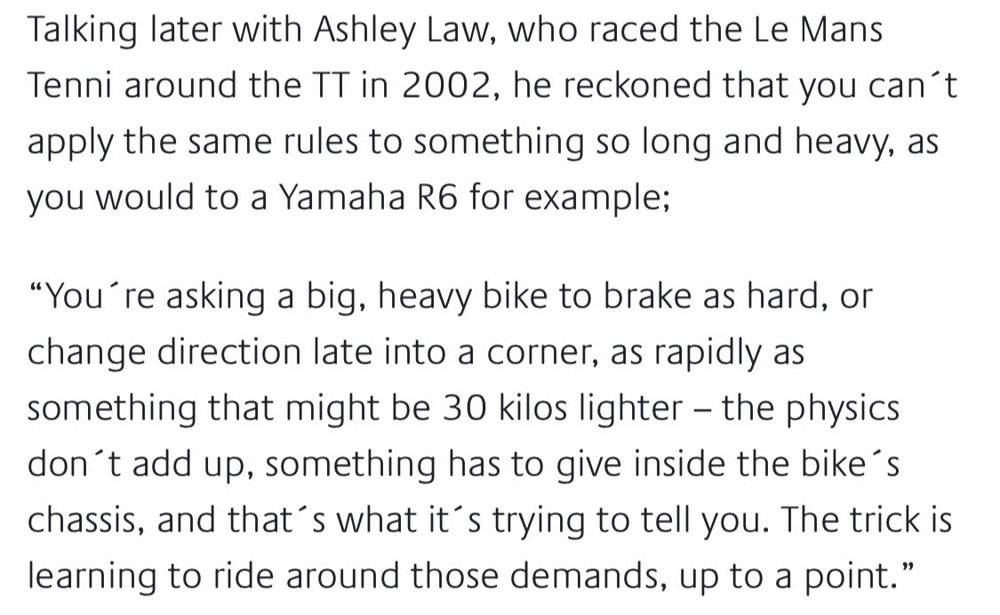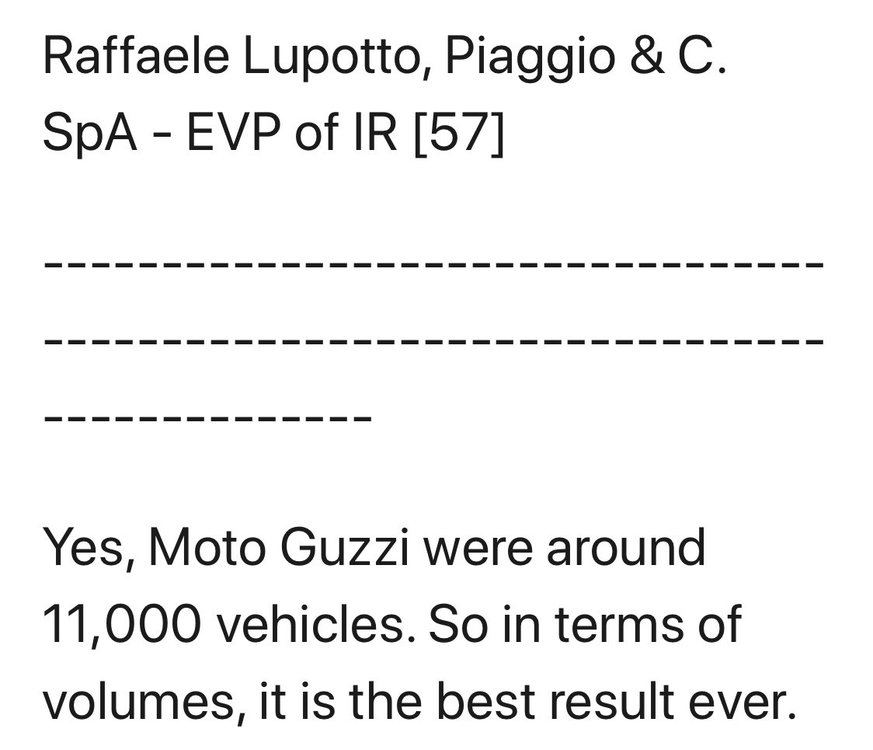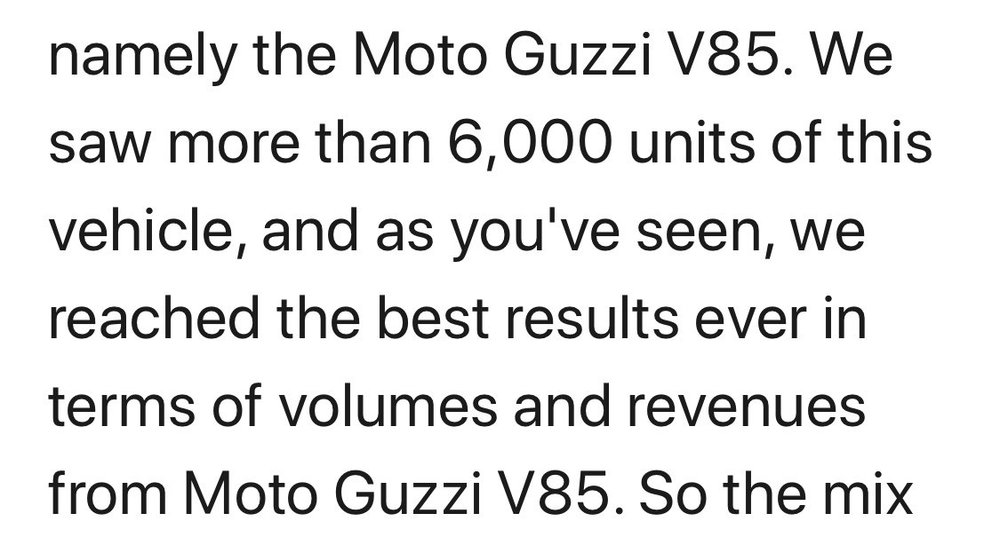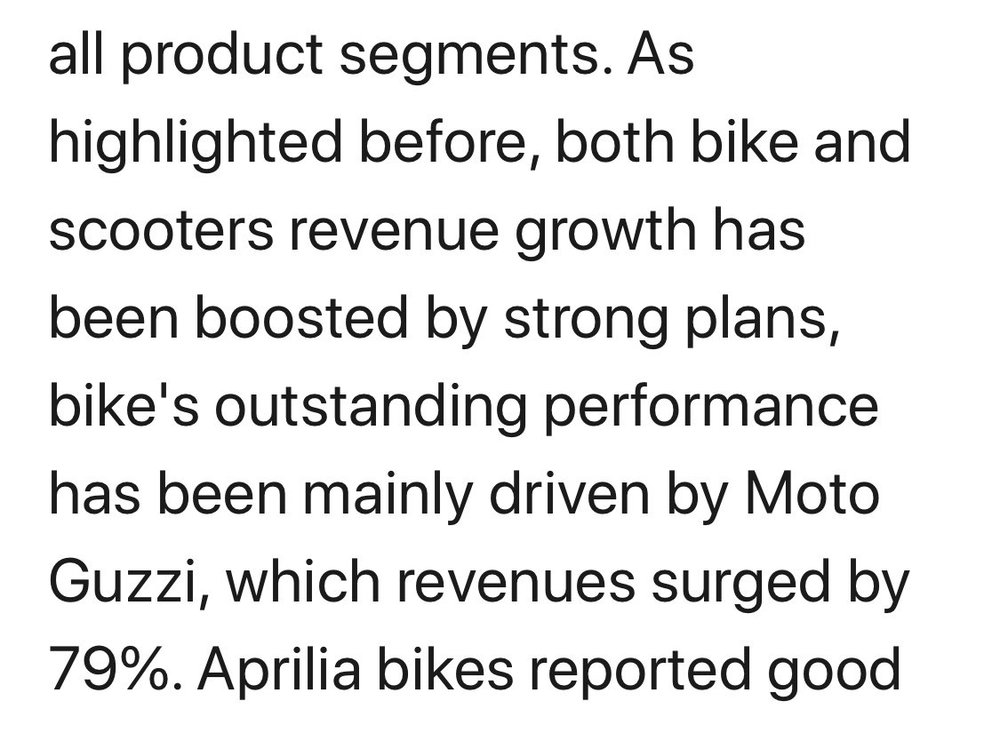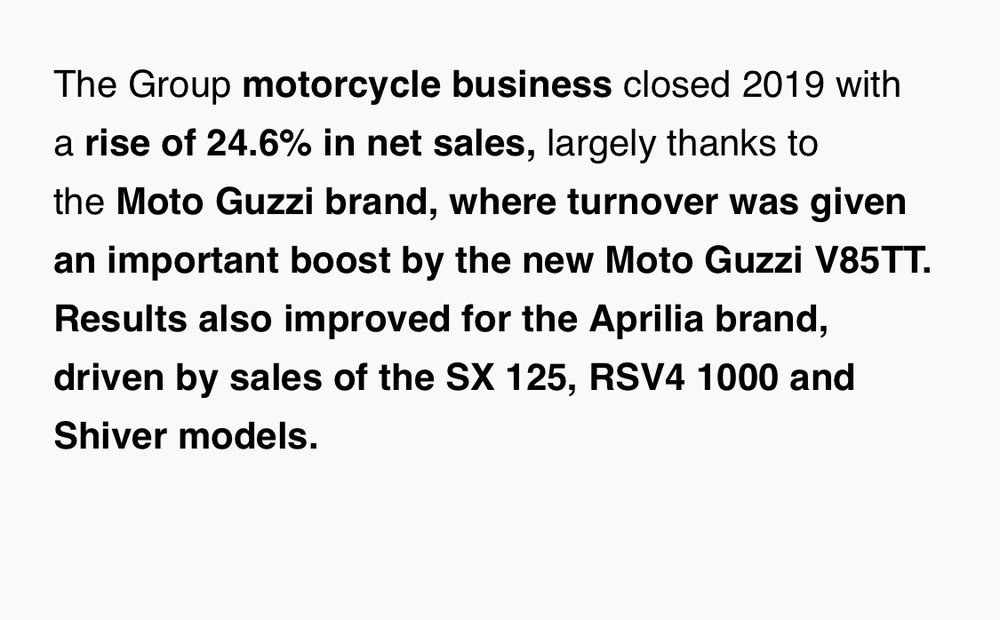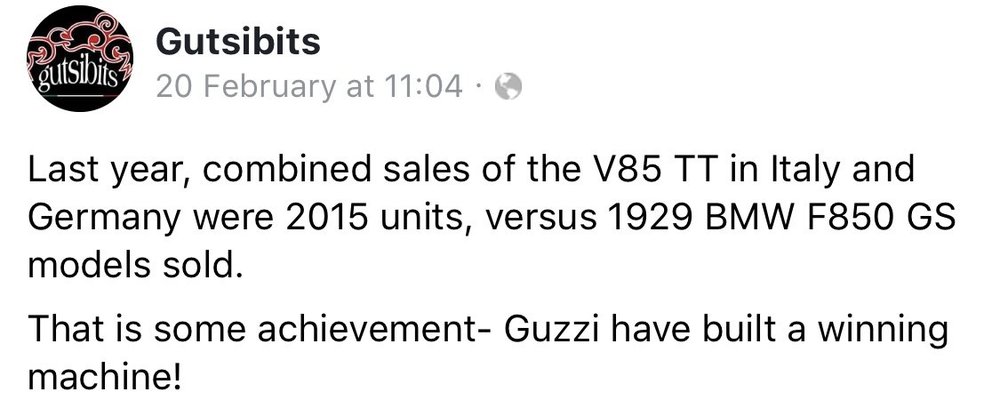
ScuRoo
Members-
Posts
739 -
Joined
-
Last visited
-
Days Won
22
Content Type
Profiles
Forums
Events
Gallery
Community Map
Everything posted by ScuRoo
-
🙏’s for Paul This bloody 🦠 is 🦇crazy deadly serious - stay safe!
-
Well, well, well - here’s a turn up for the record books! http://www.parisdakar.it/en/dakar-1986-test-graziano-rossi-sulla-moto-guzzi-750/ The Genesis of the GOAT drifting a race prepped Guzzi!! “Excited” and “lot’s of potential” superlatives abound - was this the seed of an idea sown by a 4-valve Dakar prepared racer which germinated years later... giving birth to the chiselled Zaeta? Does this Dakar Guzzi spirit hover over hallowed Tavullia ranch dirt? 😇 The Butterfly Effect really is real. Have you ever experienced it?
-
(Insights on V65 TT Dakar history from the man himself...) Claudio Torri, the man with the eagle in his soul: "The V85 TT? Bella, it was time!" The coloring of the Moto Guzzi V85 TT is a tribute to the V65 brought to the Dakar in 1985 by an architect from Bergamo protagonist of an all-Italian adventure https://www.inmoto.it/news/news/2020/03/31-2884303/claudio_torri_l_uomo_con_l_aquila_nell_anima_la_v85_tt_bella_era_ora_/2/ Can you tell us what pushed you to race the 1985 Paris-Dakar with the V65 TT? "After participating in two Atlas Rally in Morocco, two Pharaohs Rally in Egypt and a Paris-Dakar always riding a KTM, and being left alone (my friend" Ciro "De Petri had switched to Honda), I decided to change, trying to customize a bike myself. Based on the experience I had accumulated, I wanted to race with an Italian bike and this could only be a Moto Guzzi. For my way of driving, I understood that the best choice was to switch to a twin cylinder: with a single cylinder I was forced to always keep the gas open so as not to lose speed, while with the twin cylinder, thanks above all to better torque, I could slow down and then resume speed more easily. The choice of the model was required : I took what the market offered, also considering the very short time available to prepare it and introduce myself at the start. Ah, I would like to highlight the fact that in my experiences I had inc terrible identi, while, when I was riding the Guzzi, only normal falls ". What were the strengths of this bike? "The lightness. It was the least heavy of the twin cylinders. And, to save even more weight, we mounted the NATO gearbox that allowed us to start the pedal, avoiding the starter. The V65 always started at the first pedaling and it was a lust for someone like me, which came from the experience of the Mono Rotax 560. Furthermore, the Guzzi consumed little and this allowed us to take on less petrol and travel lighter or not have to stop to refuel during the special tests. V arrangement of the engine allowed for good cooling and a fairly low center of gravity. On a mechanical level, it had good accessibility and easy maintenance. " A bike that has felt "his" from the first meters ... "I got on the bike for the first time on the occasion of the prologue of Cergy-Pontoise, near Paris, because before I hadn't had time to try it and I was surprised by its behavior, despite being almost standard. On hard-bottomed tracks it was also fast if he had any cycling limit, while the limited horses made themselves felt on the sandy ones. Until the day of rest in Agadez we encountered only minor setbacks, no engine or gearbox problems. Without the inconvenience to the battery, I think the bike would have arrived safely in Dakar. " And what were the defects? "There were only two major limitations: the chassis that should have been of the off-road type due to the great stresses to which it was subjected and the rear cardan transmission that limited the rear suspension travel. Then we all know that the drivers are never satisfied, especially in a tough race like the Dakar: I would also have liked more power, more torque and a gearbox with a different spacing with the first, second and third gear long and the fourth and fifth closer together ... ". What is the most curious thing that happened to you when you competed in the Dakar with this bike? "Without a doubt the interest that the motorcycle aroused during the technical checks in Paris: after the official means, my Guzzi certainly did not go unnoticed and was the most photographed one. I confess that I also pulled it a bit, because they came to see it and the Japanese also study it ... ". And what is the most beautiful memory? "The most beautiful memory was the privilege I had to run these races with the Moto Guzzi and with the Mandello del Lario eagle on the helmet. And then an anecdote, which gave me the opportunity to publicly put a Italian sports director of a Japanese company. During the race, this person often said that I was Italy's shame and that the eagle had become a chicken. When I heard it, I replied: 'Eagles can fly as low as the chickens but the chickens will never fly high like eagles, deserving the compliments and pats on the shoulders of the people present ". Why did you choose yellow and what effect did the colors of your bike have on the new V85 TT? "The bike had been painted in the colors of the Acerbis Plastics to thank Franco Acerbis. Thanks to our friendship, he made for me the only 50-liter tank in sheet metal ever produced in his life. Moreover, we did not have the time to make a model and mold and then transform it into plastic. With my partner and colleague, architect Giacomo Ghilardini, we had tried to personalize the bike to the best that we had available. I was pleased with Moto Guzzi, but I think it must go to memory of Giacomo, who recently passed away. He later contributed to the creation of the Guzzi "Tropicana" for the 1988 edition of the African race ". What do you think of this new model produced by Guzzi? "I reply using the many comments that I heard on my short trip to Italy: 'It was time!'. I am happy that Moto Guzzi has created, without distorting its history, a model in step with the times. To be beautiful is beautiful but I have not yet had the pleasure of trying it, I have read only the technical data sheet and some very positive reviews. I therefore hope that the Piaggio Group will continue in this perspective and bring the Moto Guzzi up high, where eagles dare ".
-
Hope thief is caught & bike found undamaged Todd ...but dude! What an absolutely pearler of a shot - full of moody lighting & intrigue! What’s the go there with that setting?
-
ColdandWet Check out the M4’s here FalcoLion is Vlad
-
No that’s not correct. Their model # MG9114 was V11 specific - bolted right up perfect! What is more likely now is if they have discontinued - but it’s worth asking.
-
Great price... Email Vlad Pakht - ask him for M4 Exhaust’s Guzzi model # MG9114 vladpmisc@optoline.net Why? LOUD!! More noise with a Xover Compression also adds...
-
The absolute best part of this sobering news is that Paul is getting better! What a relief! Best wishes for Paul’s 100% complete recovery with no lingering lung damage or diminishment to Paul’s future quality of life. 👍🤒🍻 This is an incredibly bizarre phenomena with such unusual symptoms. The inclination of this Dr is that is more akin to high altitude lack of oxygen than viral pneumonia. Take care.
-
Rear https://m.ebay.ie/itm/Amortisseur-Ohlins-MG127-S46HR1C1S-Moto-Guzzi-V11-1999-2002-G7-/401133930305?_mwBanner=1&_rdt=1
-
V11 Öhlins available ... http://yahoo.aleado.com/lot?auctionID=u167787209 https://www.ebay.com/itm/Moto-Guzzi-FRONT-FORK-LEGS-V11-CAFE-01490283-GU01490283-GU01490283-01490283/133238620581?_trkparms=aid%3D1110001%26algo%3DSPLICE.SIM%26ao%3D2%26asc%3D40719%26meid%3Dcd15708843564ce8be292d0e56b7acc2%26pid%3D100623%26rk%3D4%26rkt%3D6%26sd%3D132887255397%26itm%3D133238620581%26pmt%3D0%26noa%3D1%26pg%3D2047675&_trksid=p2047675.c100623.m-1
-
Do this exercise.. 1) Price up all the Öhlins bits 2) Add a little for Aprilia level QC 3) Factory Titanium pipes 4) A little extra for the paint scheme 5) Numbers built - Rarity value 6) Condition & mileage of the remaining usual shared componentry 7) Sheene’s X factor to round it off - Desirability to Women ...And pays your money ps. Guarantee whoever stole it for $7000 is laughing with delight!
-
Tribute to “Greater Love...” Priest
ScuRoo replied to ScuRoo's topic in Special place for banter and conversation
Meanwhile, over the pond.. https://youtu.be/RWXe3f0oIAQ -
You won’t be satisfied unless you add ‘nude’ 🤤
-
You’ll find those details further down here... At the end of the nineties appeared the rather extremely designed V 10 Centauro, a touring engine in which, however, the eight-valve engine from the 1000 Daytona was used. After this the eight-valve would disappear from the program again. The investments of Finprogetti (see "company") led immediately to the Moto Guzzi Sport 1100 Iniezione, the 1000 Daytona RS and the V10 Centauro, with the Sport 1100 in particular being a big improvement over its predecessor. Company The 10 million dollars that the sale of Benelli produced was largely put in the renewal of the production lines of Moto Guzzi by Alejandro de Tomaso. In 1996 the company of the Tomaso was renamed Trident Rowan Group. Moto Guzzi remained a part of it, but the company name became Moto Guzzi S.p.A. Until the nineties, all developments were done at Maserati, which was also part of the De Tomaso group back then. The Tomaso was in the mid-nineties still 51% owner of Moto Guzzi, but after the sale of Maserati started within the company doubts about the future and the development was taken back into its own hands. Because the development work had been outsourced to Maserati for many years, there was a backlog within the factory; for example, in 1994 there were already CAD equipment, but not enough staff to work with it. Production had fallen to 3,000 motorcycles a year in the mid-1990s. That was not due to the demand but to the defective production possibilities. This meant that importers and dealers could not meet the demand. In 1994 Moto Guzzi tried to take over the machinery of the bankrupt supplier Motoplat (electronic ignition), but the angry workers had already destroyed their machines. As a result, one had to go back to contact points for the Moto Guzzi 1000 Strada, among other things. In 1995, DTI (De Tomaso Group) bought the investment bank Finprogetti, which enabled new investments to be made in its own brand Moto Guzzi. In 1995, after 30 new employees were hired, an in-house development department was set up and 336 people were employed, 5.314 motorcycles were built again. Finprogetti appointed Arnolfo Sacchi as general manager, but in 1997 he was replaced by Oscar Cecchinato, who had previously worked at Aprilia. Together with technical director Angelo Ferrari he made plans to develop new models, but also to outsource large parts of the production to supply companies. There should even be liquid-cooled models. In 1998 there was a move to the former Philips factory in Monza and Moto Guzzi bought the concept of the 650cc-Gilera Nordwest with the intention to make a "Fun Bike". In addition, Piaggio agreed to supply a number of 125 and 180 cc engine blocks for scooters. Yet Moto Guzzi closed the nineties with a debt of 132 billion lire, more than 20 million Euro. There was a battle between Ducati and Aprilia to take over Moto Guzzi and even KTM was mentioned. In the spring of 1999, the former director of Ducati / Cagiva, Mario Scandellari, became director of Moto Guzzi. Model overview in the nineties l General In 2000, there was indeed the desire to release many new models, but no new technology came. Almost all new motorcycles were based on the California and the V 11 Sport. They all had fuel injection. The V 11 models arrived just in time to replace the then already failed V 10 Centauro. Each Moto Guzzi was called a "character engine" in tests. A pet name for motorcycles where everything was wrong but it was forgiven because it was a Moto Guzzi. The finish of the machines was generally reasonable, but they were all wrong. Very nicely designed dashboards were covered with beautiful lights that were barely readable, the spring settings were extensive, but the swivels to adjust the suspension almost unreachable. The jiffy always stood too far forward so that he was barely folded in or out on the motorcycle. Because of the eighty years of existence, in 2001 the California 1100 EV 80 was released, which was designed in collaboration with the furniture designer Poltrona Frau. The custom of Aprilia to release a more luxurious version of various models with expensive components from Öhlins and Brembo was also applied to Moto Guzzi motorcycles, especially on sporty models. Gradually the finish was improved. In 2002, the Moto Guzzi Style Laboratory was set up, where new designs were made under the guidance of Giuseppe Ghezzi (known from the Ghezzi & Brian models). From 2003, the influence of Aprilia became visible when many new and modern designed models came onto the market. The finish was greatly improved and a new model line was developed with the Breva, Griso and the MGS-01 Corsa. Injection was applied to all models and that was sometimes criticized, because it was difficult to start, walk and react two-cylinder engines just as nicely as carburetor machines. However, the stricter European emission standard made it almost impossible to use carburetors. The 940 Bellagio represented an attack on the American market, particularly on the Harley-Davidson Sportster. The Stelvio and the Norge had to compete with BMW models, the R 1200 GS and the R 1200 RT respectively. Company Around the end of the twentieth century there were many rumors about a takeover of Moto Guzzi by KTM and Ducati, but in April 2000 the company was taken over by Aprilia. Roberto Brovazzo was appointed as director of Moto Guzzi, but the hand of Aprilia owner Ivano Beggio was visible everywhere. A new production line was built with a capacity of one hundred engines per day, the technical staff was expanded by 30 men and there would be 5 billion lire invested in the company. Aprilia had already paid 40 million dollars for the brand, but invested another 120 million dollars. The factory was refurbished, new equipment was purchased, two production lines were set up and the Moto Guzzi Museum was modernized. In 2003, Moto Guzzi lost no losses for the first time in years, but also no profit. In the spring of 2004 it became known that Aprilia was in big trouble. The production of both Aprilia and Moto Guzzi motorcycles came to a standstill. The cause lay in the collapsing scooter and moped market in Italy through the introduction of the helmet duty, but also through the investments in Moto Guzzi and disappointing sales of a number of Aprilia models. Although investors were soon found, the future of Moto Guzzi remained uncertain. The buildings were sold and returned, but the intention was that the factory would eventually be demolished. In December 2004, Piaggio took over Aprilia and with it Moto Guzzi. This resulted in a stable situation, as a result of which the motorcycles that were mainly based on the Moto Guzzi Griso were still produced in 2012. In 2012, the main engine was the 1200cc- History Edit Moto Guzzi was actually a flourishing company in the nineties, which, however, experienced problems due to the outdated means of production, which prevented it from meeting demand. To turn the tide, owner DTI (De Tomaso Industries Inc.) bought the investment bank Finprogetti. The production of parts was outsourced to suppliers. This was done with the brakes (Brembo), suspension (Marzocchi, Koni and WP), ignition systems (Motoplat and later Magneti Marelli) and fuel injection (Weber-Marelli). In 1990, the Moto Guzzi 1000 Daytona was introduced to the market, a pure sports motor with an expensive one, in collaboration with Dr. John Wittner developed 1000 cc eight-valve with overhead camshaft. The machine was quite popular, especially after it had been developed and fuel injection had been given, but failed in the real objective: to beat the fast Ducati superbikes. To reduce the price, an 1100 cc engine with a similar power was developed, but simpler and cheaper technology, the four-valve Sport 1100 with the underlying camshaft. He initially had problems because adjustment of the carburation was difficult, but when this machine also received injection, the tide turned. In order to get more financial return from the Daytona engine, it was built into the V 10 Centauro, but also for the 1100 cc engine they looked for more applications. First he was built into the California 1100 and the California 1100 Iniezione (1994). In the meantime, Oscar Cecchinato had become general manager and he, together with technical director Angelo Ferrari, had plans to release many new models for which this engine would be extremely suitable. The first machines that were named "V 11" were the V 11 Bassa and the V 11 Sport. The Bassa was actually a stripped California model, but all other V 11s were sports engines. The model line was quickly expanded from 2000 under the influence of Ivano Beggio, director of Aprilia, but after the takeover of Moto Guzzi in April 2000 now also by Moto Guzzi. V 11 Sport As early as November 1997, the V 11 Sport was shown at the Milan Motor Show, along with the V 10 Centauro Sport (with the Daytona engine). Appearance there were big differences, and of course the engines were different, but both machines used the part of the bicycle that still originated from the 1000 Daytona / Sport 1100. The V 11 Sport was a light, sporty motorcycle that was drawn much easier than the Centauro Sport and was executed without any extras. The frame was red, a reference to the Moto Guzzi V7 Sport from 1971, the tank / seat combination was in silver gray. Only a year later - again in Milan - the final version was shown as it would be on the market in 1999. Now the sheet metal was sprayed light green / metallic, so the machine was positioned as a "retro bike", because now the colors were completely identical to the old V7 Sport. New was the six-speed gearbox. Above the duo seat was a sphere cap, which emphasized the sporty appearance. In the meantime, two years passed between the first introduction and production. That was not strange to Moto Guzzi, after the introduction they realized that the production lines were too small to really start building the machine. Motor The engine was an air-cooled longitudinally placed 90 ° V twin that delivered 91 hp. Both the cylinders and the cylinder heads were made of aluminum, the cylinder sleeves were equipped with a nikasillaag. The valves were operated by push rods and tumblers from a camshaft that lay above the crankshaft. Carburetors were no longer there; just like the Sport 1100, the V 11 Sport had a Weber-Marelli injection system, but with the V 11 Sport it was the 15M type without an EPROM chip. He did have the M16 system of the Sport 1100. The flywheel had become lighter to obtain a better gas generation. An alternator was mounted on the front of the crankshaft. The starter motor was on the left side next to the gearbox. The crankshaft turned in plain bearings, as well as the connecting rods. The engine was equipped with an oil cooler. Drive line The crankshaft directly drove the double dry plate coupling via the flywheel. Behind it was a new six-speed gearbox that was 7 cm shorter than the old five-speed gearbox. The secondary drive was via a cardan shaft. The cardan shaft (thanks to the benefit of the shorter gearbox) was 5 cm longer. The coupling was hydraulically operated. Bicycle part The V 11 Sport had a backbone frame, but the engine was the main supporting part with aluminum sketch plates at the back where the swingarm hinged and at the front a small tube made of tubes with the headset attached. At the front was a fully adjustable Marzocchi Upside Down front fork and behind a cantilever monovering with a horizontal WP damper. At the front were two 320 mm Brembo disc brakes, at the rear a 282 mm Brembo disc brake. Compared to the Sport 1100 the wheelbase was slightly shorter and the battery was further forward to obtain a more favorable center of gravity. V 11 Sport Rosso Mandello In 2001, Moto Guzzi celebrated his 80th birthday. For the occasion, some special models were released, such as the California 1100 EV 80 and the V 11 Sport Rosso Mandello. The Rosso Mandello was of course red, including the sketch plates of the rear suspension and the cylinder covers. He also had a small carbon fiber steering box. It was built in a small edition of 300 numbered copies. Technically there were no differences with the V 11 Sport. V 11 Le Mans Later than the Rosso Mandello but in the same year the V 11 Le Mans was presented. Now a number of technical changes had been implemented. The machine had a large top half-cockpit, but two small additional frame tubes were installed between the engine and the rear wheel suspension plates to provide better stability. There was also another steering wheel mounted and a wider 180 mm rear wheel. The Le Mans referred in name to the older Moto Guzzi Le Mans, whose production had already ended in 1993, but was less spectacular in design. It was a modified V 11 Sport, and it was less extremely designed than the original Le Mans. The V 11 Le Mans was delivered in red and in chrystal-metallic, but many parts were painted black, such as the engine crankcase, the valve covers, the gearbox, the final drive, the front fork, the dashboard, the front fender, the exhausts and the wheels. Only the sketch plates for the rear fork bearings were still bright red. Noteworthy was the modification to the coupling, which now had a single dry plate instead of the usual double dry plates. That meant that the much criticized heavy service belonged to the past. V 11 Sport Naked The Sport Naked came in 2002 as the successor of the V 11 Sport in the catalog, although the models were available for a while next to each other. The addition "naked" made sense because both the Sport Rosso Mandello and the Le Mans had a form of a streamlined cockpit. A number of changes to the Le Mans were now also implemented on the basic model, such as the reinforcements on the frame and the wide rear wheel. V 11 Sport Scura In 2002, with the V 11 Sport Scura an attempt was made to build the "best steering Moto Guzzi ever". This was done by adjusting the bicycle part considerably: At the front there was an Öhlins 43 mm Upside Down front fork and also the rear shock absorber and the steering damper were replaced by Öhlins. Like the Le Mans, the machine had a single dry plate coupling. "Scura" means "dark" and the machine was almost completely black. Many parts were made of carbon fiber, such as the mudguards, the cover over the duo seat, the standard exhaust silencers and the side covers. The Scura had a small steering box. V 11 Le Mans Tenni In 2002 the V 11 Le Mans Tenni appeared. The name was a tribute to the famous Guzzi driver Omobono Tenni, who was successful in the 1930s and for Moto Guzzi. However, the colors were from the fifties: aluminum-colored motorcycle with a green top half and a brown suede saddle, as applied to the eight-cylinder, among other things. That motorcycle had never seen Omobono Tenni, because he died in 1948. Technically, the Le Mans Tenni was identical to the V 11 Le Mans. V 11 Ballabio The V 11 Ballabio was introduced in 2004 and was a V 11 Sport Naked with a small steering wheel. The name was taken from the Ballabio-Resinelli race. V 11 Playboy EE The V 11 Playboy EE (Exclusive Edition) was presented at the Brussels Salon in early 2003 in the presence of the Belgian Playmate Tanja Dexters. The motorcycle was completely silver gray sprayed and had a new engine management system, which he delivered 7 hp extra. The exhaust system was made of titanium and the new owners received an annual subscription to the Playboy magazine and an invitation to the Playboy jubilee party. V 11 Café Sport and V 11 Coppa Italia Both of these models came on the market in 2004 and were based on and technically similar to the V 11 Sport Naked, but performed slightly differently. Both had a small steering box, but were more expensive due to the Öhlins adjustable front and rear suspension. The Café Sport was golden bronze in color and the cylinder covers were bronze colored. The Coppa Italia was gray / green with a red stripe, the colors of the flag of Italy. The Coppa Italia was a "Limited Edition". V 11 Le Mans Rosso Corsa and Nero Corsa The V 11 Le Mans Rosso Corsa came on the market at the end of 2003. As a result of the custom at Aprilia (since 2000 owner of Moto Guzzi) to build special, exclusive and more expensive models of their models, the Rosso Corsa got the best parts available. The brakes w spikes Brembo Serie Oro and the suspension was provided by Öhlins. The compression was slightly increased, which had no consequences for the top power, but improved the power delivery in the middle area. In addition, the new balancing pipe between the outlets and the new catalyst also helped. The sturdy cockpit with a simple, round headlight was already becoming old-fashioned. The Rosso Corsa had a red tank, cockpit, sketch plates, seat and valve covers. The V 11 Le Mans Nero Corsa was technically identical, but black / dark gray blocked. V 11 Sport Scura R The V 11 Sport Scura R came in 2005. The machine was completely black, except for the sketch plates, the top of the tank and the seat. Öhlins suspension and carbon fiber had been used, which meant that the machine fell into the "luxury" segment
-
There will be a time when we all will look back on how this coronavirus pandemic has affected us all - some more so than others. This touching story about Giuseppe Berardelli and his sacrifice for another unknown younger man deserves a fitting tribute. He obviously loved his trusty red Galletto - wouldn’t it be wonderful for Moto Guzzi to aquire and display his pride & joy to their collection? A modern story for these times that will stand for decades to come as a tribute to the selfless priest and his greatest of all love. I sure would stop and ponder if I ever get to visit Mandello del Lario. https://www.google.com.au/amp/s/www.eternitynews.com.au/world/greater-love-72-year-old-priest-gives-up-his-respirator-to-a-younger-person-and-dies/amp/ Stay safe everyone.
-
Of course it’s “special” - name one V11 which isn’t? However, there’s one quality which stands out which “models” are special - the ones equipped special - those running Ohlin’s. That said, imo the Tenni model is uniquely special - as the only V11 to ever have raced at the Isle of Man TT 🇮🇲 Bravo! Respect.
-
-
Above sourced: https://www.google.com.au/amp/s/finance.yahoo.com/amphtml/news/edited-transcript-pia-mi-earnings-214733393.html
-
-
-
-
If Guzzi profits increase - it provides wherewithal to invest in new Martini engined 2021 Le Man. It’s all good either way! Sourced: https://www.totalmotorcycle.com/piaggio-group-reports-significant-19-improvement-in-profits/
-
-
https://www.motociclismo.it/moto-special-moto-guzzi-le-mans-4-75591




